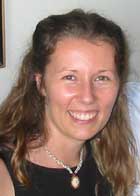REDMOND, Wash., April 4, 2005— What’s ethnography? And what on earth could practice of the exotic-sounding research field have to do with a technology like Microsoft’s Tracey Lovejoy is an ethnographer on the Microsoft User Experience User Research team, a part of the Windows Client business unit. She joined the team in July 2001, right out of graduate school, where she studied ethnographic methods and anthropology. In this Q&A, Lovejoy explains how her field of research impacts technology –and the next generation of the Microsoft Windows operating system.
PressPass: What is an ethnographer, and how does that fit with technology?

Tracey Lovejoy, Ethnographer, Microsoft User Experience User Research Team
Lovejoy: Ethnography is a qualitative research method for understanding patterns of behavior in everyday life and the ways they are shaped by culture. Ethnography utilizes a mix of methods, most notably participant observation, as well as in-context interviews, semi-structured interviews, diary studies, collaging/visual representations, triangulation with statistical data and application of theoretical frameworks.
The ultimate goal is to understand the holistic view of the world from our participants’ eyes, as opposed to viewing the world from our own perspective. For Microsoft, this translates to understanding how our customers — and potential customers — experience the world and how technology fits into that experience.
Ethnographers at Microsoft study people; look at their behaviors, values and desires, then make recommendations about how technology can better serve people’s lives. This translates to feature ideas, product improvements and new potential markets. Our mantra is that technology should conform to people’s lives, supporting their existing needs and behaviors, rather than people’s lives having to conform to technology, changing their needs and behaviors.
PressPass: How does your work observing how people use technology fit with the development of features and functions in Windows products?
Lovejoy: I try to help ground our planning and development in the real-world scenarios and behaviors of our customers. If we can understand our customers’ lives, needs and pain points, we can make products that can really help them. This manifests in many ways. In the planning and early milestone phases, I work closely with product-team members across disciplines such as user research, project managers, testers and developers. I try to be the relentless voice of the customer.
PressPass: Can you give a few examples of how your work has led to product enhancements, or maybe even the creation or a new product or way of doing something?
Lovejoy: In the course of my time at Microsoft, I have worked on several studies, from a longitudinal enterprise information-worker study, Office Space, during early planning for “Longhorn”[the code name for the next version of the Windows operating system], to more exploratory work with populations Microsoft does not always focus on, such as baby boomers and their parents, and also thinking about how technology could serve the family as a unit, rather than the individuals that make up the family. I have also worked on wireless hotspots, including time with truckers, working with local community technology centers and those that fall into the Digital Divide, and I run an international study, Windows to the World, showing how cultural differences can impact technology use.
Each of these studies has had different types of impact across various teams. The Office Space study was targeted at “Longhorn” planning work, looking at storage and communication models that helped frame some of the early thinking around metadata and folder continuity that customers will see in the next version of Windows. “Longhorn” will take advantage of much of this work.
All of the exploratory and international work was conducted jointly with my counterpart, Nelle Steele. Many findings from our short, local studies have been used in strategy planning and some implementation in teams across the company. Our family-unit work resulted in a family-calendaring project with MSR [Microsoft Research] and strategizing with Works. Our baby-boomers work led to new product development with the Microsoft Hardware division and idea generation with the Microsoft Home team. From our Digital Divide work, we have partnered closely with the Unlimited Potential program and Windows Shared Access Computing.
PressPass: Can you provide a brief example of what a typical day or week is like for you?
Lovejoy: There are days in the field and days in the office. When in the field, I spend full days with my customers. For example, one day in Finland in 2003, I arrived at the family’s home at 7:30 a.m., they ate their breakfast, packed up, and I jumped in the car with the mother and father. The father dropped the mother and me off at the metro, where we traveled to her job at the Helsinki Opera House working as a department scheduler. I sat near her desk most of the day, taking notes, photos and video of her behaviors, actions, interactions and conversations. I would follow her to other offices and meetings. At the end of the day, we stopped at the market, then on to her language class, then home in the evening. The next day, I followed her son to high school.
When in Redmond, my days look much like other product-team people: meetings, meetings, meetings, e-mail, e-mail and trying to get data analysis and reports done in between the meetings and e-mail.
PressPass: What do you want fellow employees to know about the value an ethnographer can bring to technology and product development?
Lovejoy: Ethnography brings the voice of the customer directly into product development. The best way for anybody to get the “religion of the customer” is for them to meet and observe as many customers around the world as possible. However, because this doesn’t scale, ethnographers can serve as proxies to bring that knowledge and experience back to the team and help guide product development to best serve our customers. Through deep data analysis, video and photographs, our customers’ needs can be brought to life and clearly articulated.




